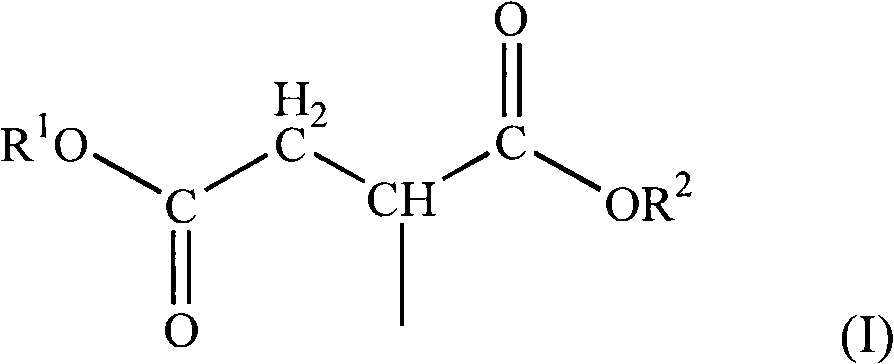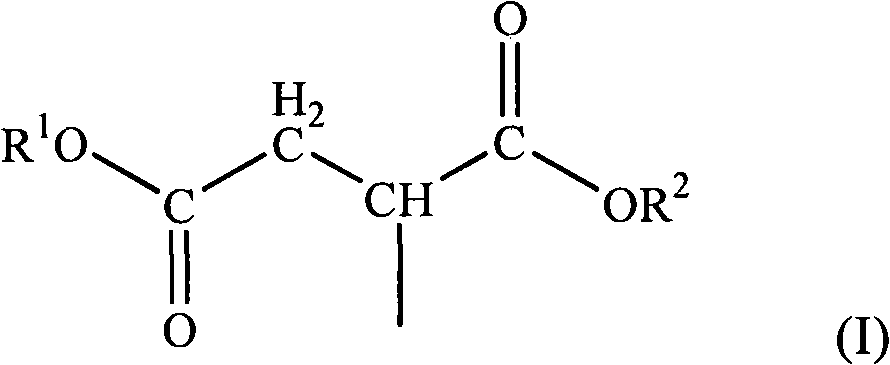Bio-based polyol
一种多元醇、烃基的技术,应用在多元醇领域,能够解决材料粘稠等问题
- Summary
- Abstract
- Description
- Claims
- Application Information
AI Technical Summary
Problems solved by technology
Method used
Image
Examples
Embodiment 1
[0034]Embodiment 1: prepare bio-based polyester resin (polyol) (comparison)
[0035] project
Monomer / Intermediate
Amount added (g)
1
1000.90
2
222.27
3
Ethylene glycol
304.77
4
glycerin
0.34
5
Butyltin tris(2-ethylhexanoate)
1.23
[0036] 1. Add items 1 and 2 to the reactor at ambient temperature (approximately 25°C).
[0037] 2. Heat the resin to 200°C while stirring under nitrogen.
[0038] 3. Resin is held at 200°C for 2 hours, viscosity is monitored at 1 hour intervals.
[0039] 4. Cool the resin to about 50°C.
[0040] 5. Add items 3, 4 and 5 to resin over 10 minutes; hold at 50°C for 30 minutes.
[0041] 6. Heat the resin to 100°C and hold at 100°C for 30 minutes.
[0042] 7. Heat resin to 225°C and hold at 225°C until AV < 5 (monitor AV and viscosity at 1 hour intervals).
[0043] 8. When AV≤5, the resin is cooled ...
Embodiment 2
[0045] Embodiment 2: preparation bio-based polyester resin (comparison)
[0046] project
Monomer / Intermediate
Amount added (g)
1
1004.85
2
maleic anhydride
222.92
3
Ethylene glycol
284.10
4
glycerin
0.38
5
Butyltin tris(2-ethylhexanoate)
0.58
[0047] 1. Add items 1-2 to container at ambient temperature (25-30°C).
[0048] 2. Heat the resin to 200°C while stirring under nitrogen.
[0049] 3. The resin is maintained at 200°C for 2 hours, and the viscosity is monitored every hour.
[0050] 4. Cool the resin to about 50°C.
[0051] 5. Add item 5 to the reactor.
[0052] 6. Add items 3 and 4 to the resin over a period of 10 minutes; hold at 50°C for 30 minutes.
[0053] 7. Heat slowly to 100°C and hold for 30 minutes.
[0054] 8. Resin was heated to 210°C and maintained at 210°C for 1 hour, monitoring AV and viscosity every hour.
[0055] 9....
Embodiment 3
[0058] Embodiment 3: preparation bio-based polyester resin (comparison)
[0059] project
Monomer / Intermediate
Amount added
(gram)
1
1006.80
2
maleic anhydride
223.20
3
Ethylene glycol
283.58
[0060] project
Monomer / Intermediate
Amount added
(gram)
4
glycerin
0.36
5
Butyltin tris(2-ethylhexanoate)
0.51
[0061] 1. Add items 1-2 to container at ambient temperature (25-30°C).
[0062] 2. Heat the resin to 200°C while stirring under nitrogen.
[0063] 3. The resin is maintained at 200°C for 2 hours, and the viscosity is monitored every hour.
[0064] 4. Cool the resin to about 60°C.
[0065] 5. Add item 5 to the reactor.
[0066] 6. Add items 3 and 4 to resin over ten minutes; hold at 50-60°C for 30 minutes.
[0067] 7. Heat slowly to 100°C and hold for 30 minutes.
[0068] 8. Heat...
PUM
| Property | Measurement | Unit |
|---|---|---|
| hydroxyl value | aaaaa | aaaaa |
| hydroxyl value | aaaaa | aaaaa |
| hydroxyl value | aaaaa | aaaaa |
Abstract
Description
Claims
Application Information
 Login to View More
Login to View More - R&D
- Intellectual Property
- Life Sciences
- Materials
- Tech Scout
- Unparalleled Data Quality
- Higher Quality Content
- 60% Fewer Hallucinations
Browse by: Latest US Patents, China's latest patents, Technical Efficacy Thesaurus, Application Domain, Technology Topic, Popular Technical Reports.
© 2025 PatSnap. All rights reserved.Legal|Privacy policy|Modern Slavery Act Transparency Statement|Sitemap|About US| Contact US: help@patsnap.com



